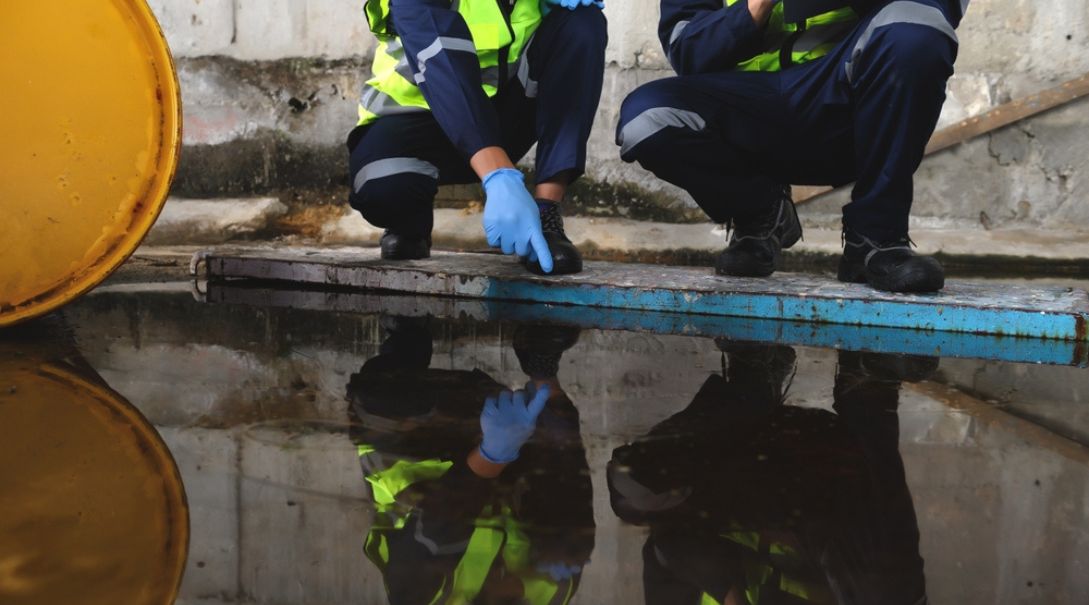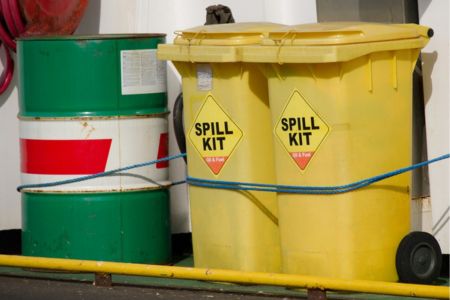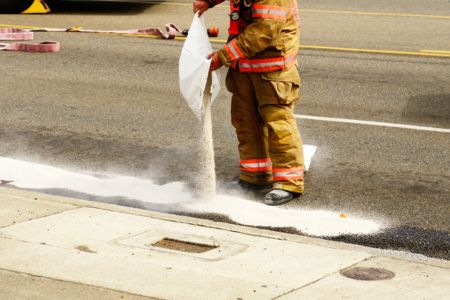Fuel spills can cause significant damage. They are potentially hazardous to the environment, wildlife, and human health. Knowing what to do if you have a fuel spill is key to obtaining the best possible outcome.
When fuel spills occur, an urgent response should be given. It is also extremely important to handle fuel spills correctly. This blog post will provide straightforward, comprehensive information on what to do if you have a fuel spill, including immediate actions, safety measures, and professional cleanup procedures.
Table of Contents
Immediate Actions to Take
Specific and immediate actions should take place to minimize risk and damage. Here are critical steps that explain how to handle a fuel spill:
Ensure Personal Safety
Safety should be your first priority. Gasoline and diesel fuel can pose a serious danger. Quickly evacuate all non-critical personnel from the immediate area of the fuel spill, providing a safe distance of at least 150 feet. Block off the area around the spill, if possible.
The spill clean-up team should wear appropriate personal protective equipment (PPE). In commercial and industrial sites where fuel is stored and/or used frequently, on-site should have designated areas where PPE is kept for swift access.
Avoid creating ignition sources in the area, such as sparks or flames. This is essential to ensure personal safety when a fuel spill occurs.
Stop the Source
Examine the source of the spill. Has a container been turned over? Is there a leaking valve? Is there more than one source? Once this is determined, quickly take action. Use the appropriate number of personnel (but no more to limit risk) to stop the source.
Turn off the leaking valve, upright the leaking container, or use other necessary actions to prevent the spill from getting bigger.
Contain the Spill
Once the source is stopped, take necessary actions to contain the spill. Standard fuel spill handling protocols are important to ensure safety and effective, efficient containment.
Methods that can be used, depending on the specifics of the fuel spill, include:
- Using barriers to keep the spill from spreading further
- Using absorbent materials
- Using spill kits
It is important to contain the spill as quickly as possible to limit the spread. Risks and hazards from fuel spills can include:
- Explosions and fires
- Increased potential for falls and injuries
- Environmental damage
- Property damage
- Health issues from inhaling fumes, including headaches and dizziness
- Health issues from prolonged skin exposure, including skin irritation and burns
Keep safety personnel properly trained to ensure proper containment of fuel spills.
Ventilate the Area
Ventilation is also critical. This will provide airflow to disperse potentially harmful fumes from the fuel. Safely ventilate the area. Open doors and windows while being careful of any fuel ignition risks.
Mechanical ventilation, such as commercial fans, can be used cautiously. Place the equipment safely away from the fuel to ensure no potential sparks could ignite a fire or explosion in a gas spillage or diesel spill. The larger the fuel spill, the more vital it is to have enough ventilation for any gasoline or diesel fumes that can be harmful to human health.
Safety Precautions to Follow
Essential safety precautions should be followed when determining what to do if there is a fuel spill, including avoiding open flames and sparks, using personal protective equipment, and notifying authorities.
Avoid Open Flames and Sparks
Flammable and combustible fuels require special precautions to prevent them from catching fire or creating an explosion, which could potentially cause injury to personnel, property damage, and harm to the environment and wildlife.
Avoid open flames and sparks, and immediately eliminate any potential ignition sources in the fuel spill area. Warehouses and other commercial and industrial properties often have multiple ignition sources.
Potential ignition sources include:
- Thermal – cigarette lighter, blow torch, welding flame, pilot light, soldering iron, hot slag, electric lamp, glowing ember, cigarette butt
- Electrical Current – electric motor, electric switches, cable break, spark created under short circuit or other fault conditions
- Electrostatic Charge – rubbing of plastic or rubber, pneumatic conveying of the solid flow of liquid in a pipeline, powder flow, liquid spray generator, arc weld
- Mechanical – due to faulty or damaged equipment (friction or fracture)
- Chemical – exothermic reactions
Use Personal Protective Equipment (PPE)
Personal protective equipment (PPE) is necessary when there is a fuel spill. Fuel produces fumes that can have bad health effects, are viscous and slippery, and cause falls. It can also harm or burn skin, particularly with prolonged contact.
PPE needed when dealing with a fuel spill:
- Eye protection—use goggles or safety glasses. Protects eyes from splashes and fumes.
- Gloves—Wear gloves made of neoprene, nitrile, or other chemical-resistant material. Do not use gloves made from absorbent material. Gloves protect hands when coming into contact with fuel.
- Respirator—Use a quality respirator, particularly in areas with poor circulation or confined space. It protects the lungs and throat, preventing harmful effects from fumes.
- Foot protection—Wear non-slip, safe footwear for fuel spills. This will protect personnel from injuries caused by slips and falls.
Flame-resistant clothing (FRC) will also be needed if an ongoing fire or circumstances present could cause ignition or combustion. Depending on the circumstances of the fuel spill, hearing protection may also be needed.
Notify Authorities
Another important safety precaution is notifying authorities of the fuel spill. This should be conducted in accordance with spill response protocols and regulatory requirements, as well as for personnel and public safety.
Report the spill to local authorities and any necessary state authorities, and notify emergency services, especially for large spills. The greater the volume of the spill, the increased risk of fire, explosions, or other hazards. Here are guidelines for reportable incidents per the Florida Department of Environmental Protection:
- Petroleum-based spills.
- Spills into or involving state waterways (any amount).
- Spills greater than 25 gallons (or potential > 25 gallons).
- Spills requiring any state/federal notifications or assistance.
- Chemical spills.
- All SARA/EHS/CERCLA releases.
- All spills threatening the population or the environment.
- All spills requiring evacuation.
The types of information that should be provided include:
- Your name, location, organization, and telephone number
- Date and time of the incident
- Location of the incident
- Source and cause of the release or spill
- Types of material(s) released or spilled
- Quantity of materials released or spilled
- Medium (e.g., land, water) affected by release or spill
- Danger or threat posed by the release or spill
- Number and types of injuries or fatalities (if any)
- Weather conditions at the incident location
- Whether an evacuation has occurred
- Other agencies notified or about to be notified
- Any other information that may help emergency personnel respond to the incident
Cleaning Up the Spill
Here is a step-by-step guide on how to clean up a fuel spill safely and effectively:
Absorb the Spill
Fuel is very flammable – the cleanup should be conducted the right way.
The technique utilized to remove the fuel spill is absorption. However, it is important to use the correct types of absorbent materials. They should be made from materials with high porosity and retention.
Do not use rags, shop towels, paper towels, or similar materials. This would be dangerous because they could ignite. Use commercial pads and rolls and/or loose absorbents There are a variety of appropriate loose absorbents that can be used, including:
- Commercial absorbents
- Sand
- Peat moss
- Vermiculite
- Clay absorbents, such as kitty litter
Check for any drains and use barriers or absorbent material to prevent fuel from flowing into them. Barriers or absorbent material should also be used to protect soil nearby at risk of contamination.
Wearing appropriate PPE, spread the absorbents starting from the outside edges and working toward the center of the spill. This will help prevent the spill from spreading further. Use thicker absorbents first for thicker pools. Then, use finer materials to remove residual traces of liquid. Apply the absorbents thoroughly, covering the entire area of the fuel spill. Allow enough time for all the liquid to be fully absorbed.
After this, the absorbed fuel must be safely disposed of. Most spill kits should contain a large shovel to scoop up the absorbents. A large broom can also be used to sweep into a shovel or large dustpan. All equipment used should be non-sparking. Depending on the spill’s size, you may need to reapply more absorbent. Repeat this step until all fuel is absorbed.
Place these in appropriate, tightly sealed containers. These should be stored in a safe and secure area away from any potential sources of ignition.
Clean the Area
Once the spill is absorbed, the area should be methodically and thoroughly cleaned. Ensure all personnel involved in this step use appropriate PPE, including gloves and eye protection.
Pour an appropriate detergent or specialized cleaning agent over the affected area. Then, let it sit for at least 10 minutes (or per the cleaning agent’s specific directions). It is important to give it time to penetrate the residue on the surface/concrete.
Next, scrub the cleaner into the surface using a stiff brush or broom. Apply firm pressure and use circular motions to achieve the best results. Depending on the amount of residue left after the absorption stage, cleaning agents may need to be reapplied.
Be comprehensive when cleaning and ensure that no residual fuel is left. This would risk potential fires, explosions, or other dangers.
Rinse the area with water and absorb the liquid/solution with mops, wet vac, or absorbents. Be thorough with rinsing, as leftover detergents can cause slip hazards. Then, the area should be fully dried. Continue to ventilate with open doors and windows. Fans can be used to speed up the process. Once the surface(s) are completely dry, they will be safe for personnel to use.
Dispose of Contaminated Materials
Separate the waste into categories – used absorbents and liquid (fuel). This will aid in efficient disposal and maintain compliance requirements.
The materials should then be safely disposed of according to local and state waste regulations, Occupational Safety and Health Administration (OSHA) standards, and Environmental Protection Agency (EPA) regulations. It is recommended that local environmental authorities coordinate to identify licensed hazardous waste disposal sites and arrange transportation.
When to Call Professionals
With the potential danger and long-term repercussions of fuel spills, it is critical to call professionals when you need them. Professionals have the training, knowledge, skills, and experience and should handle cleanup and any necessary environmental remediation efforts in the following scenarios:
Large Spills
Large fuel spills are hazardous and can quickly turn into significant disasters. Spill response and remediation professionals have the essential knowledge, training, and equipment to tackle the complexity and risks of large spills.
From stopping the source and dealing with containment on a variety of surfaces to effectively cleaning up a high volume of liquid to reduce costly damage — professionals have the ability to handle large spills properly, efficiently, and within regulatory guidelines.
It is not recommended to tackle large spills without appropriate expertise. Fuel is highly flammable, potentially combustible, and can cause additional health hazards due to fumes and improper handling. Environmental services professionals have the skills and experience to manage large spill emergency situations.
Environmental Impact
Consider the environmental impact when deciding what to do if a fuel spill occurs. Multiple consequences may occur that negatively affect the greater area of the spill.
Potential impacts of fuel spills can include:
- The fuel contaminates the soil, harming the land and natural habitats.
- The fuel leaches into nearby surface or groundwater, affecting plants, animals, and human drinking water sources.
- The fuel’s fumes contaminate the air, creating respiratory problems or other serious illnesses.
These impacts are dangerous in the short term and can have long-term environmental consequences if the fuel spill is not properly handled from the beginning.
It is also important to note that professionals are continually trained in the ongoing changes in local, state, and federal regulations. They understand when and how to modify procedures or techniques to ensure compliance with environmental regulations and help prevent companies from facing costly fines.
Specialized Equipment and Techniques
When deciding what to do with a fuel spill, understand that professionals use specialized equipment and techniques to effectively clean up and remediate spills.
While the spill kits many companies have on-site are useful in certain circumstances, other fuel spills need specialized equipment and techniques to handle them appropriately.
Different equipment is optimal for containment, clean-up, and remediation depending on the fuel spill’s source, volume, and location.
Specialized equipment includes:
- Heavy equipment includes vacuum trucks, track hoes, skid steers, broom attachments, roll-off trucks with roll-off boxes, and dump trucks.
- Pumps
- Generators
- Air compressors
- Cordless tools
- Pneumatic tools
- Various hand tools
Environmental solutions professionals provide full-service spill management and cleanup, including:
- Stabilization and containment
- Water and wastewater cleanup and emergency response
- Site cleanup, remediation, and restoration
- Containment boom/berm deployment
- Emergency hazardous waste and spill response
- Full-service waste management, among other services
Contact AOTC for Professional Fuel Spill Cleanup
AOTC provides expert assistance with emergency spills and quick response times for public and private incidents. For gas or diesel fuel spill cleanup, trust AOTC to provide comprehensive solutions that ensure safety, environmental protection, and compliance with all regulations.
We have the expertise, professional training, and experience necessary to deliver true quality service and comply with all regulatory agencies. AOTC has successfully managed a variety of transportation and industrial incidents, including fuel spills from vehicle accidents, overturned tractor-trailers, vehicle fires, and spills from industrial accidents.
Contact us for 24/7 emergency response.


